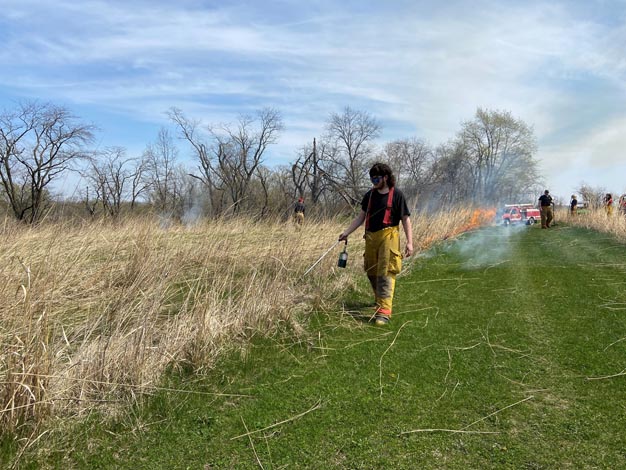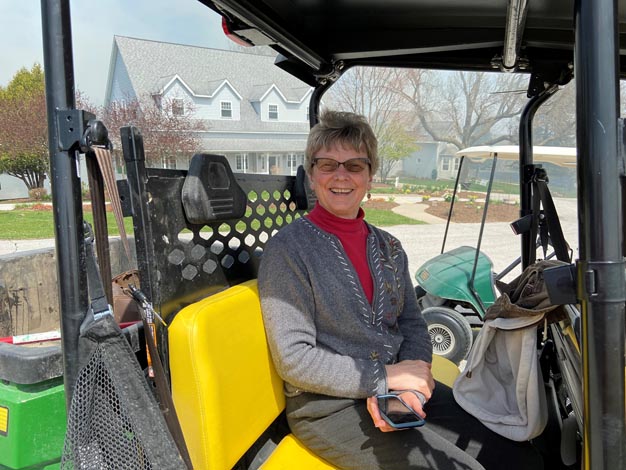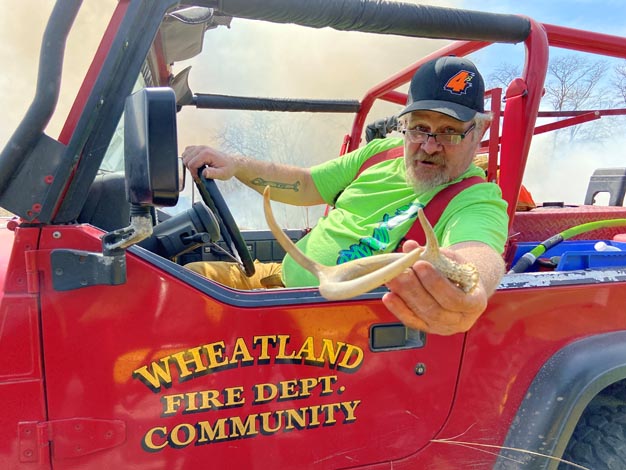
Firefighters from the Wheatland Fire Department do a controlled burn at Our Lady of the Prairie Retreat Center April 17. The burn helps maintain a healthy prairie.
By Barb Arland-Fye
The Catholic Messenger
WHEATLAND — At a pace, firefighters from the Wheatland Fire Department spaced at strategic points around a section of prairie ignited the ground with fuel from hand-held canisters. Flames licked the earth, turning it black and plumes of white and yellow smoke rose from the ground to blanket the blue sky at Our Lady of the Prairie Retreat on April 17. “Oh boy, they are going to see this in DeWitt!” exclaimed Sister Margaret Kruse, OSF, the Prairie’s director.
Setting fire to the prairie, or prairie burn, is one of many tasks required to maintain the health and safety of the Prairie. The prairie burn took place five days before Earth Day, an annual event begun April 22, 1970, in response to degradation of the environment. Respect for all of Creation is the mission of Our Lady of the Prairie, and its sponsor, the Congregation of the Humility of Mary.
The Prairie, which straddles Scott and Clinton counties along the Wapsipinicon River, abounds with wild flowers, 56 acres of native grass prairie, 25 acres of woodland and rolling hills and 16 acres of fire lane (paths that also serve as walking trails). It remains a focus of the Sisters to protect, restore and care for the land. Hospitality is another aspect of that mission, an invitation to others to grow in appreciation of Creation.
Over eons, glaciers carved out what would become the Prairie and formed its rolling hills, Sister Margaret said. All of Iowa once looked like the Prairie, said Todd Seifert, the property and operations manager. After John Deere invented the steel plow in 1837, Iowa’s immigrant farmers were able to convert the rich soil of the native prairieland into cropland. By 1900, the transformation was complete.
Patience, perseverance, trust in, and appreciation for God’s role as creator and humankind’s responsibilities as stewards of creation play out daily at the Prairie. Invasive plant species, such as reed canary grass, require attention and repeated cutting.
The derecho, a widespread long-lived windstorm that struck Iowa last August, extended the hands-on care for Prairie workers and volunteers. Todd points toward a pile of tree branches and what looks like green netting (invasive vine) that has been cleared recently. Other invasive species, which may look like just another flower or plant, do not escape Sister Margaret’s eyes as she takes her daily walk around the prairie, pulling weeds out with satisfaction.
The reed canary grass took root, stubbornly, in recent years because of unusual and persistent flooding. “It will come in and take over. It will consume other plants because it grows so fast,” Todd said. “The root system is so thick. It doesn’t let anything else through,” Sister Margaret added. With part-time staff, Sister Margaret and Todd work persistently to cut it down.
The prairie burn assisted in that effort. In fact, prairie burns occur throughout the Midwest to keep prairies safe and healthy. “The goals of lighting these fires are to restore nutrients to the soil by removing them from dead organic matter, to prevent invasive species from out-competing native prairie plants, to remove dry lingering ‘tinderbox’ plant matter, and to maintain a grassy environment where woody trees would otherwise takeover” (Dana Simon, illinoisscience.org, 9-23-19).

Sister Margaret Kruse tours Our Lady of the Prairie Retreat grounds April 17.
Weather conditions and the fire department’s availability necessitated the later date for the prairie burn in Wheatland. As they watched from a safe distance, Sister Margaret and Todd marveled at the differences between this year’s prairie burn and last year’s burn in another section of the Prairie. Drier conditions last year caused the flames to rise more quickly and resulted in less smoldering.
Mice scurried out from beneath the grass, invasive hawthorn trees and other plant debris as their hiding places heated up under the firefighters’ torching. “Look, there’s a mouse! Run little guy, run!” Todd said, as he drove the Prairie’s all-terrain utility vehicle along one of the “Rabbit Ear” sections of prairie being burned.
During a dialogue on climate change in September 2019, Sister Johanna Rickl, CHM, reported that her congregation had recently completed a conservation easement on part of the land near the Prairie. She said that action may improve the health of the Wapsipinicon River and should help create better habitat for many plants and animals.

Terry Hagg with the Wheatland Fire Department holds an antler found on the property of Our Lady of the Prairie Retreat in Wheatland.
The prairie grasses and flowers offer good opportunities for bees, butterflies and other insects to do their important work in food production, she said. Solar panels have been installed at the Prairie to produce energy that doesn’t add carbon to the atmosphere.
Just before firefighters arrived for the prairie burn, a handful of volunteers and part-time staff spent the morning mulching flowerbeds at the Prairie. Mulching maintains the moisture, enriches the soil and keeps the weeds out, Sister Margaret said.
Care for Creation also aims to enhance retreats and contemplative experiences for people seeking to nourish their relationship with God, others and nature. The coronavirus pandemic required the Prairie to move to online retreats beginning in March 2020. With vaccines now developed and being distributed, one more hopeful sign for spring has emerged. “On May 1, we’ll open up for in-person retreats,” Sister Margaret said.
At the Prairie
Our Lady of the Prairie Retreat in Wheatland is offering an online ecumenical prayer service on April 27 at 10 a.m. to pray for the earth during Earth Day month. Lay ministers will lead the free event. To register, call (563) 336-8414 or email olpretreat@gmail.com Visit the Prairie’s webpage at chmiowa.org/retreat.






